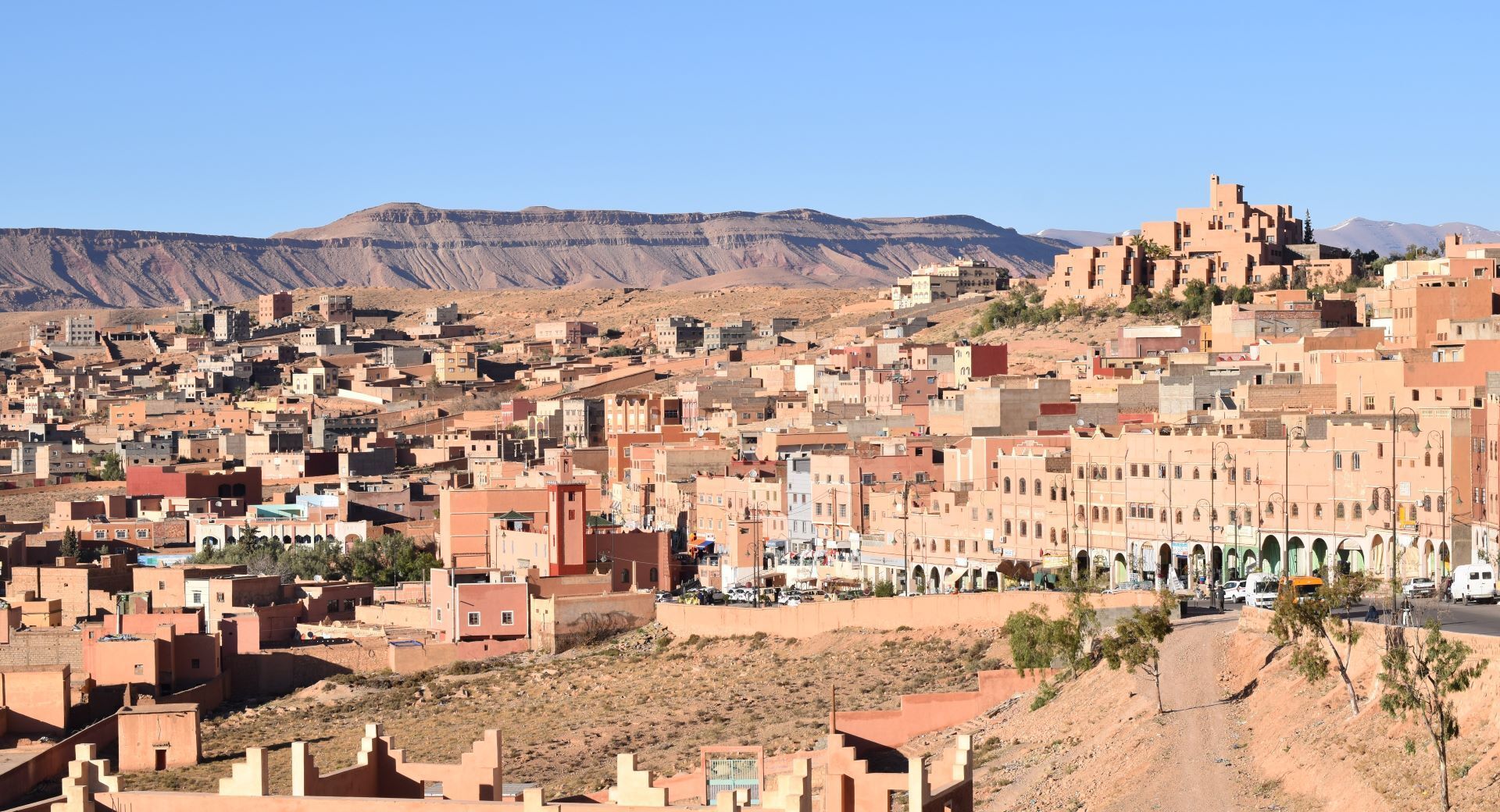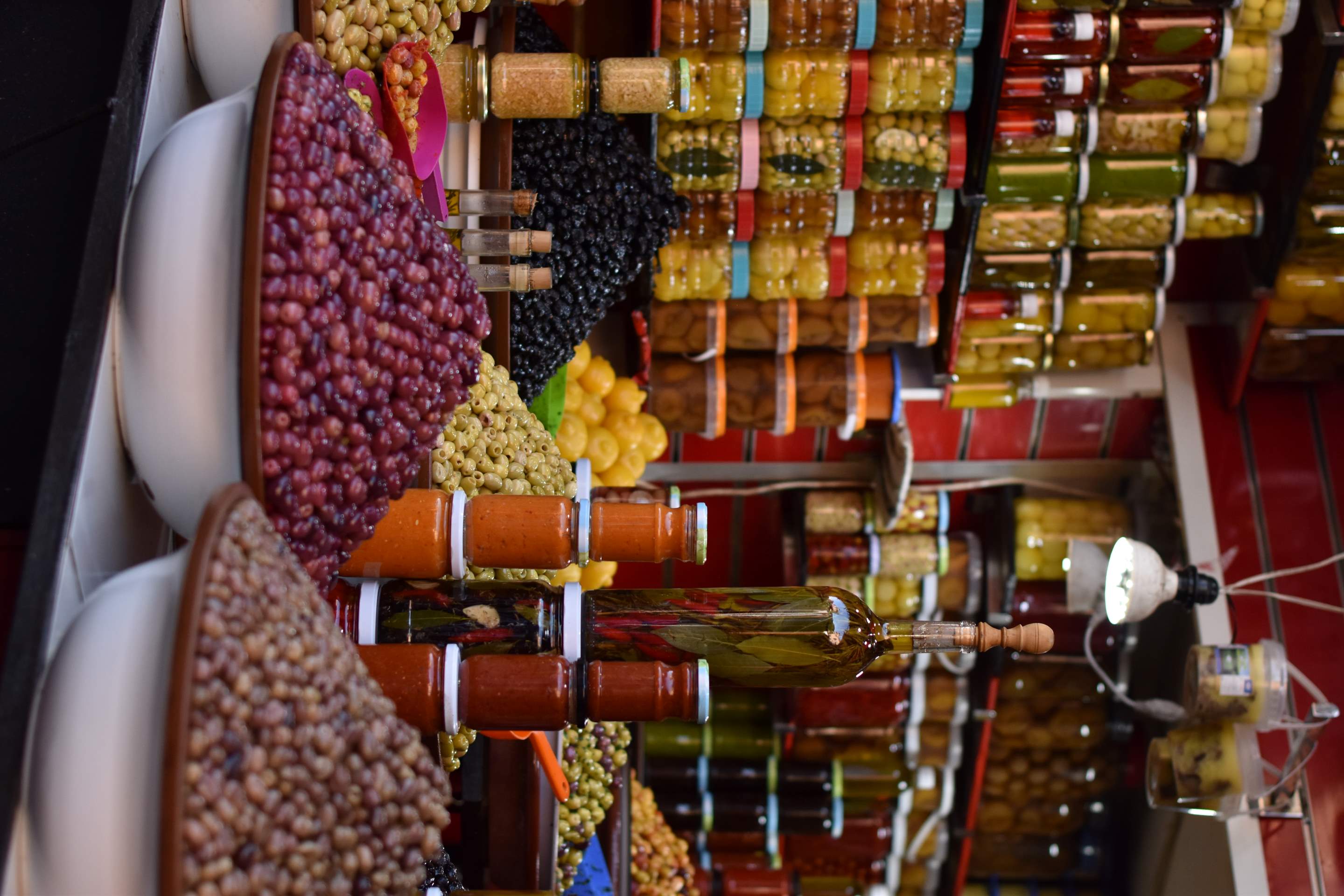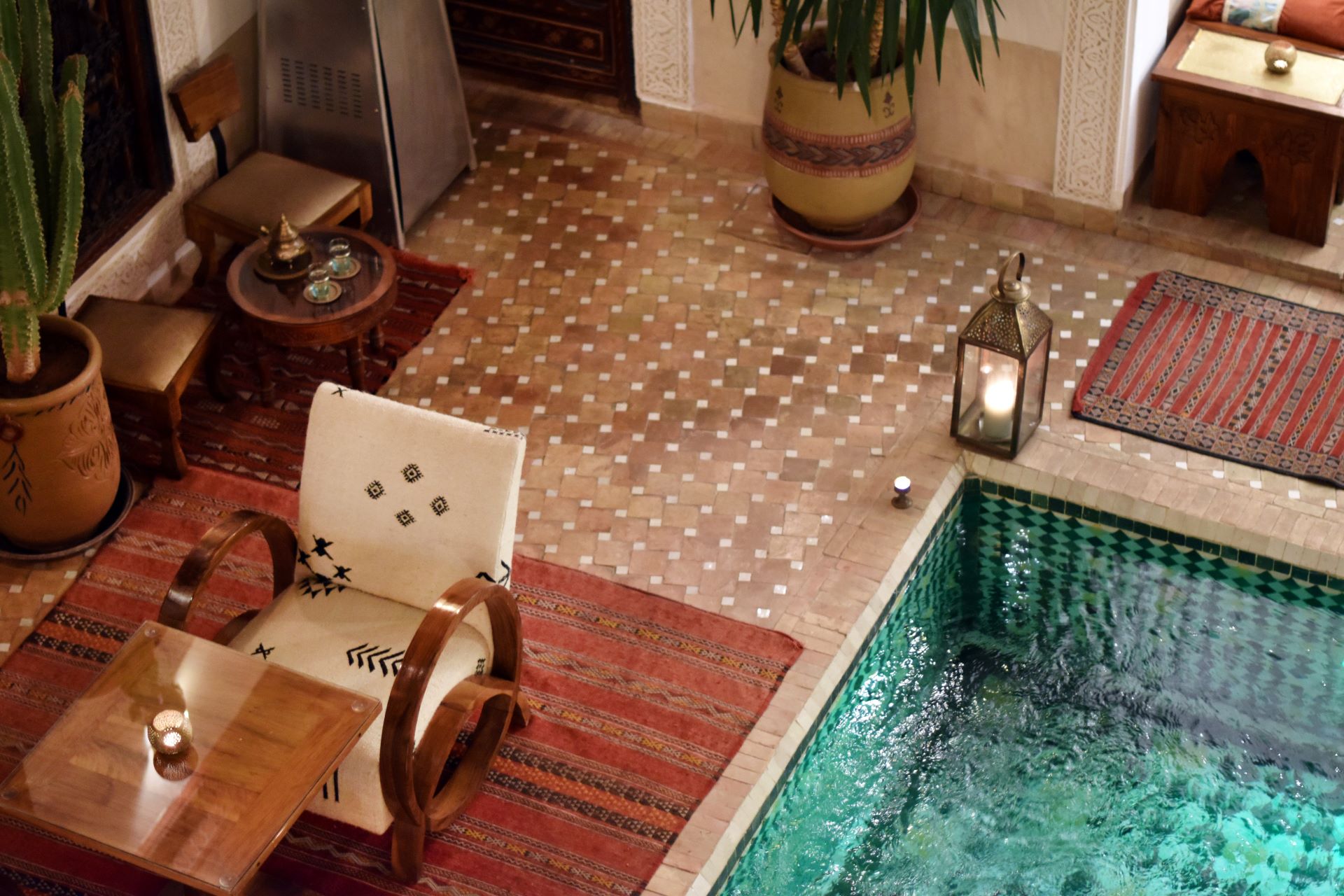
Our guide to exploring Morocco
Interest in this captivating North African country has soared in recent years. Morocco beckons with a rich history, breathtaking landscapes, diverse culture, enchanting architecture, and delectable cuisine. Join us as we unravel the allure of Fes and the dynamic cityscape of Casablanca, inviting you to explore the wonders of this mesmerizing North African gem.
Morocco’s diverse landscape
Located in North Africa and practically touching the tip of Spain, Morocco is nestled next to the Sahara desert, Algeria, and Mauritania. Its capital is Rabat, while its largest and commercial city is Casablanca. Once a French colony, Morocco gained independence in 1956 and has since become the fifth-largest economy in Africa. Like its neighbours, Morocco is an Arab country, with Islam as the dominant religion and Arabic as the national language, although French, Spanish, and English are also widely spoken, as well as the Moroccan Arabic dialect being very prominent throughout the country. Ethnically a mix of Arabs, Berbers, and Sahrawis, it has culturally picked up much from its European colonists and integrated them into its own ethnic and cultural background. For example, cafes are so plentiful around Morocco that a joke among the local populace is that "between every café is another café."
Speaking of culinary habits, Moroccan dishes have become a staple across the world. Foods such as Tagines, Couscous, Harira, and many others have touched the taste buds of many across the world, wowing them with the sauces, spices, and unique textures that make them so distinct and favourable among the many other Arab cuisines.

But one fine delight that everyone must try is Moroccan tea. Made in a unique way, the tea is cleaned in a special Moroccan tea pot or Berrad, as it's called in Morocco, before brewing for a specific amount of time. Then, herbs and sugar are added to enhance the flavour. It is then carefully poured into a glass before being poured back into the Berrad. This action is repeated numerous times to further add to the texture and flavour. After this, tea lovers rejoice at tasting one of the world's most serene teas that engulf the mouth in delectable ecstasy. When done correctly, Moroccan tea is a blessing on the senses, from its sweet aroma to its fresh and heavenly taste. It is a must-try when in Morocco.
Morocco’s enchanting architecture and environment: a feast for the senses
Morocco is home to sprawling deserts and mountains that dazzle the eyes with their golden sands twinkling ever so gracefully under the sun. The hot air of the sun also relaxes the muscles and remains comfortably warm, without becoming muggy and humid. Morocco unfolds as a tapestry of enchanting diversity, where nature, species, and climate weave together in harmonious symphony. This variety is region-dependent: some areas enjoy a pleasantly warm and non-stifling climate, while others contend with temperatures that can soar to unbearably hot and humid levels. Amid this poetic landscape, there are realms where snowflakes grace the scenery, reminiscent of conditions found in ski resorts. There is a plentiful supply of tropical palm trees, especially in Casablanca. But what makes the environment truly unique is the architecture.
While cities like Casablanca have modern skyscrapers, cities such as Fes, the famed blue city of Chefchaouen, and especially Marrakech offer a unique style of buildings to gaze at.
Exploring the timeless charm of Fes
The oldest of Morocco’s imperial cities, Fes was once the capital city of Morocco under the Marinids from 13th to 16th century A.D. It has since become a well-preserved time capsule where the remnants of pre-colonial Morocco are on full display, and is classified by UNESCO as a world heritage site.
The Fes Medina can be a hectic and frenzied place, with every turn offering new voices beckoning travellers to take a chance and purchase their wares. Handmade carpets and rugs, fine garments, tea sets, and other trinkets can be found in abundance. However, one should be wary of scams and rip-off prices. For those adept at the art of haggling, the Medina provides the perfect environment to hone those skills needed to navigate through the bustling labyrinth of shops and market stalls.
Once done wandering the busy Medina, why not visit the Fes Tanneries. The Chouara Tannery as it’s called is the largest and one of the oldest tanneries in Fes. One of the city’s most vital treasures, the tannery operates largely unchanged from its early inception in the 9th century when Fes was founded. Therefore, witnessing this tannery will be offering a glimpse into the past. Gazing at how the different dyes that fill all the numerous vats spread across the open tannery will bring both appreciation and admiration for the art of dying leather.
After navigating the bustling Medina, it's a relief to find a quiet spot. One option is to sit in the open square outside the Medina entrance, where you can watch many children out playing football and the many teenagers sitting by the steps, eating, bathing in the sun or just sitting in the shade enjoying a good book. Alternatively, take a walk across the green plains and hills towards the Bab Jdid Garden. This peaceful oasis is surrounded by lush greens and endless desert, offering shade, glistening flora, and ceramic fountains that sparkle in the sun. From time to time, musical, dance, and oral performances, sometimes Jewish, sometimes Muslim, enliven the garden. If you're lucky, you may even catch some spontaneous oral storytelling performances. Otherwise, it's an ideal place to enjoy classic Moroccan literature, such as Tahar Ben Jelloun’s 1985 mystical realism novel The Sand Child.
After a long day of exploring Fes, it’s time for a traditional, warm Moroccan meal. The charming rooftop restaurant L’Amandier at Palais Feraj provides sublime views over the Medina of Fez and its menu features delicious dishes that fuse Moroccan and Mediterranean flavours.
Chefchaouen: Exploring Morocco's fascinating Blue City
A guided tour of Chefchaouen, the Moroccan blue city, covers the long drive from Fes to the city and includes a tour of its history, culture, and the exploration of its Medina. From there, you’ll be encouraged to explore the city by yourself before reconvening at a designated spot to be taken back to Fes in the evening.
Chefchaouen is located in the Northwest of Morocco and was originally a military outpost. After the Reconquista in Spain, the city became home to many Muslim Spanish refugees fleeing from Islamic Granada. Later, it housed many Jews fleeing persecution in Europe during the 1900s before many left to settle in Israel. Spanish is widely spoken alongside French in this city. The buildings are painted in bright blue and white, which some say is meant to represent the cohabitation of Jews and Muslims in the city. The city was only painted blue when the Jewish arrived in the 1900s. Although others argue that blue acts as a mosquito repellent or represents the sky and being closer to God in Jewish culture. The city is stunning to visit, with its narrow, bright blue alleyways and various blue buildings and houses surrounding the entire city.
The Medina is now open to the public after many years of being closed off to preserve the national heritage of the Medina. So, wandering down the sharp alleyways, one of the most visible items on sale is the various dyes and paints used to repaint the buildings. You may even witness a local painting one of the walls in the distinctive colour with a large grin on their face and a friendly hello.
Finally, due to Spanish influence, Chefchaouen hosts Mediterranean style dishes alongside various fish markets across the city.
Discovering the vibrant and modern city of Casablanca
The economic and finance centre of Morocco, Casablanca is the largest city and definitely the most modern city. With high rise skyscrapers and modern buildings, this is by far the most cosmopolitan Morocco gets. Long streets lined with giant palm trees, many local artists and street dancers performing their routines, and young teens dressed in the latest fashion crazes and listening to numerous local and international musicians from their speakers make one reminiscent of Los Angeles in the USA. It's a dynamic city with a plethora of things to do.
Casablanca's coastal location has made it a centre for trade and international business, attracting goods from Europe and across the globe, contributing to its status as a financial hub. However, nestled by the crashing waves that dominate the shore of Casablanca stands the iconic Hassan II Mosque. As the sun's rays break through the clouds and shine down on the stunning architectural feat, it is an unmissable sight to behold while in Casablanca. Completed in 1993 by French architect Michel Pinseau and commissioned by King Hassan II, the mosque was meant to be a landmark and a symbol of Casablanca. The mosque's construction was so costly that it relied on funding from both the King and the public which makes it a genuine national accomplishment. It is the largest functioning mosque in Africa and the seventh largest in the world, with its minaret being the second tallest in the world. The mosque's laser, shining towards Mecca, has become a divine symbol of Casablanca's greatness, showcasing its beauty and grandeur.
The beauty of Casablanca is not just in its architecture, but also in its fashion, particularly the traditional costumes and jewellery of Morocco. The Musée Abderrahman Slaoui is a museum dedicated to the art of costumes, jewellery, and ceramics, located near Mohammed V square. The museum displays various items that are a feast for the eyes, from the superb Fes ceramics to old oriental posters from the country's colonial days. The museum's outstanding collection of rare and delicate Moroccan jewels taken from throughout Morocco's history is a vital part of any visit to Casablanca for history, art, and fashion buffs. The museum also offers workshops in calligraphy, perfect for both children and adults, providing an opportunity to learn and get their hands dirty. A visit to the Musée Abderrahman Slaoui is an excellent way to delve deep into Morocco's fascinating art and fashion history.
Paying homage to Casablanca's iconic film
Casablanca shares its name with the 1942 Hollywood Golden Age classic starring Humphrey Bogard, Ingrid Bergman and Claude Rains. Although the film is fictional, the city still pays tribute to the film that has made it famous. For those wishing to feel a part of the film’s world, stop by at Rick’s Café. Situated close to the Marina shopping centre by the shore front, Rick’s café pays great homage to the film and is a site of pilgrimage for fans of the film worldwide. Serving dishes such as its fisherman’s stew, scallops on pineapple and various selections of pastries to go with a lovely cup of warm coffee or Moroccan tea. Cocktails and other alcoholic beverages are also served along with great live musical performances across most nights, making this one of the coolest little places to find oneself in during a trip to Casablanca. For those wanting to live the movie, then Rick’s café is the place to go to complete a Casablanca trip.
Marrakesh: A vibrant and sprawling city
Quickly becoming one of the most popular tourist destinations not just in Morocco but all of Africa, Marrakesh is a lively and sprawling city that is always buzzing with music, the chatter from the many inhabitants and bright lights engulfing the streets in near-neon glows. Walking down the hectic streets both day and night will offer a new experience, whether that’s finding a nice hidden café, discovering a secret gem of a restaurant nestled between two large skyscrapers or relaxing by a pool in one of the many bars secretly placed in hotels.

Marrakesh is the fourth largest city in Morocco and is one of four Imperial cities in Morocco with the others being the aforementioned Fes, the capital Rabat and Meknes. Founded in 1070, it was the capital of the Almoravid Empire which was a Berber Muslim Empire which lasted from 1050 to 1147 when it fell to another Berber Muslim Empire in the region called the Almohads. However, the city would be restored to its capital status which it lost to Fes for many years under the Saadian Muslim state under Sultans Abdallah al-Ghalib Billah and Ahmad al-Mansur in the 14th to 15th century where it became a large trading hub. The city is often called “the red city” due to the red walls and use of red sandstone that give many of its older buildings, mosques, and houses a distinct red glow. It has now since become a massive tourist destination and is particularly popular among the French, with many French celebrities and elites buying property in Marrakech.
For those who are visiting for the first time, the UNESCO world heritage site, the Medina, is a must-visit to start the day. Enclosed by thick red walls, the medina is one of the busiest markets in Africa, consisting of various Souks to discover. It's a labyrinth of different shops selling an array of items, including carpets, leather goods, clothing, books, and street art. There's even a small record shop, where the friendly owner is knowledgeable about Moroccan musical history. Morocco has a rich musical history, and the owner offers a listening tour of Moroccan music from the 60s and 70s. One popular singer of this time is Abdelhadi Belkhayat from Fes, known for hits such as "Ya bent Nass" and "Qitar Al Hayat".
In the Sidi Abdelaziz quarter lies the Musée de La Femme or the Women’s Museum in English. One of the first of its kind in Africa, this small but impactful museum offers a tour through the cultural and artistic works of Moroccan women, celebrating their efforts and achievements. There are countless exhibitions in the three main exhibition rooms, and they are usually a rotating cast of both feminist icons in Morocco such as artist Rachida Touijri to new and upcoming artists showcasing fresh new ideas. It is highly recommended for those interested in what Moroccan women have to say and what they are contributing to Moroccan discourse and society.
A moment of respite: Tranquil gardens near Jemaa El Fna square
With bags of shopping filled with anything the heart desires it might be time to find a quieter and more secluded spot to just catch the breath and allow the thoughts to return to a sound state. The cyber park located near the Jemaa El Fna square is great for those just wanting to take a much deserved break away from the fun but chaotic scenes of the Medina. Tranquil as one walks along these green patches and ostentatious pink petals blooming brightly from the flowers from which they grow, the smells capture and hold the nose to a gentle and sweet aroma that kisses the senses. The light from the sun filters through the gaps in between the branches that cover the paths with patches of shade, perfect to sit and read or have a moment to oneself. Even better is that it’s become a playground for cats that like to come and sleep under the trees, so whilst relaxing, maybe bring some cat treats and make some new feline friends.
A country with endless wonders
Morocco has once again caught the world's attention with the world cup, showcasing the country's marvellous, generous, and welcoming people who truly deserve to be on the global stage. This attention has led to increased popularity among tourists from around the world, not just Spanish and French visitors. Morocco has something for everyone, offering enough to satisfy even the most experienced travellers. Its long maze-like Medinas keep visitors on their toes, with each corner offering a new surprise, a friendly face, and a new tasty treat to try. Overall, Morocco is an unmissable destination for adventurous travellers looking to explore this vibrant and welcoming red land.
For more travel inspiration, check out our pick of the 10 Best places to visit in France.
Photo Credits: © Irina Gorskaya for Art de Vivre
